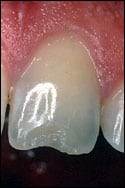Dental bonding is a cosmetic dentistry procedure that uses composite to conceal minor imperfections in teeth. The composite is applied, shaped, hardened, and polished to a natural gloss. You can receive in minutes while you’re sitting in a dental chair.
Dr. Perry can use dental bonding to make small repairs to gaps, chips, cracks, or discolorations of your teeth. Dental bonding is one of the most artistically and technically challenging cosmetic dentistry procedures because the repairs are made directly to the tooth with no assistance from computers or other technology to match the colors and translucency of the involved teeth.
Dental bonding is a great choice when the involved teeth are otherwise healthy and attractive, with just isolated problem areas.
Dental Bonding Procedure
|
The tooth pictured at right is chipped and discolored. In the first step of the dental bonding procedure, the surface of the tooth that needs to be repaired is roughened, then etched. A bonding agent is applied. The composite material (prepared by the dentist) is then applied to the area to repair the defect or cover the discoloration. Dental bonding is called a “direct” restoration because the repair is performed directly on the tooth, as opposed to an indirect method such as porcelain veneers, where the restorations are designed and created in a laboratory and then applied to the patient’s teeth. |
 |
|
| The repair to the affected tooth is completely natural looking. Notice that the tooth is not a uniform color or translucency. When Dr. Perry uses dental bonding to repair gaps or chips, he must exactly match the colors and translucency of all parts of the tooth he is repairing. The composite material must be shaped properly, then polished to match the surrounding teeth.
This is very demanding work, artistically, and few dentists have the skills and aesthetic sense necessary to do this kind of beautiful work. |
 |